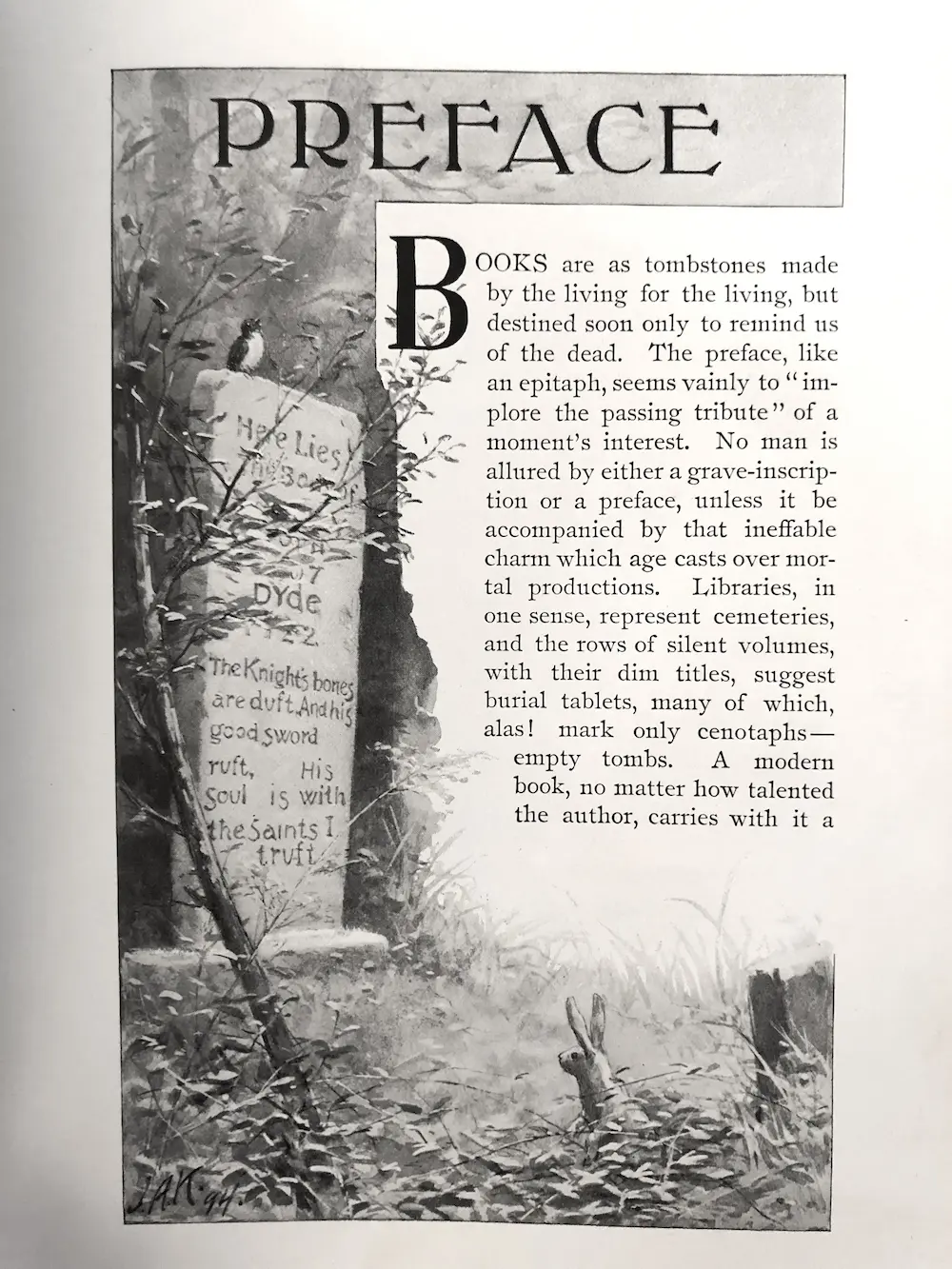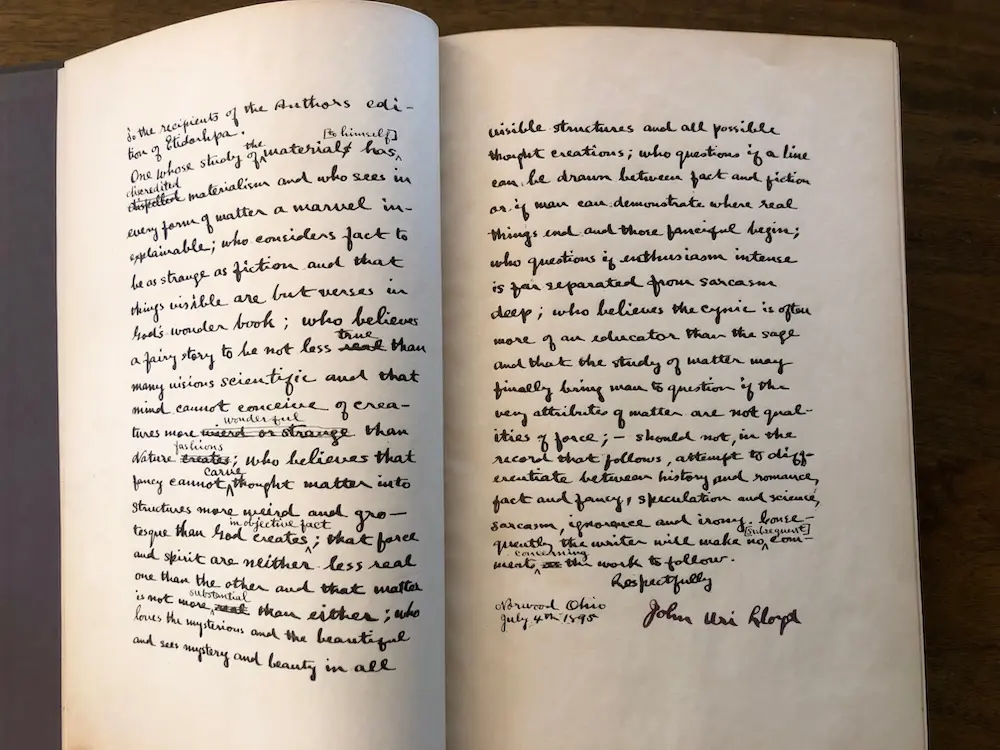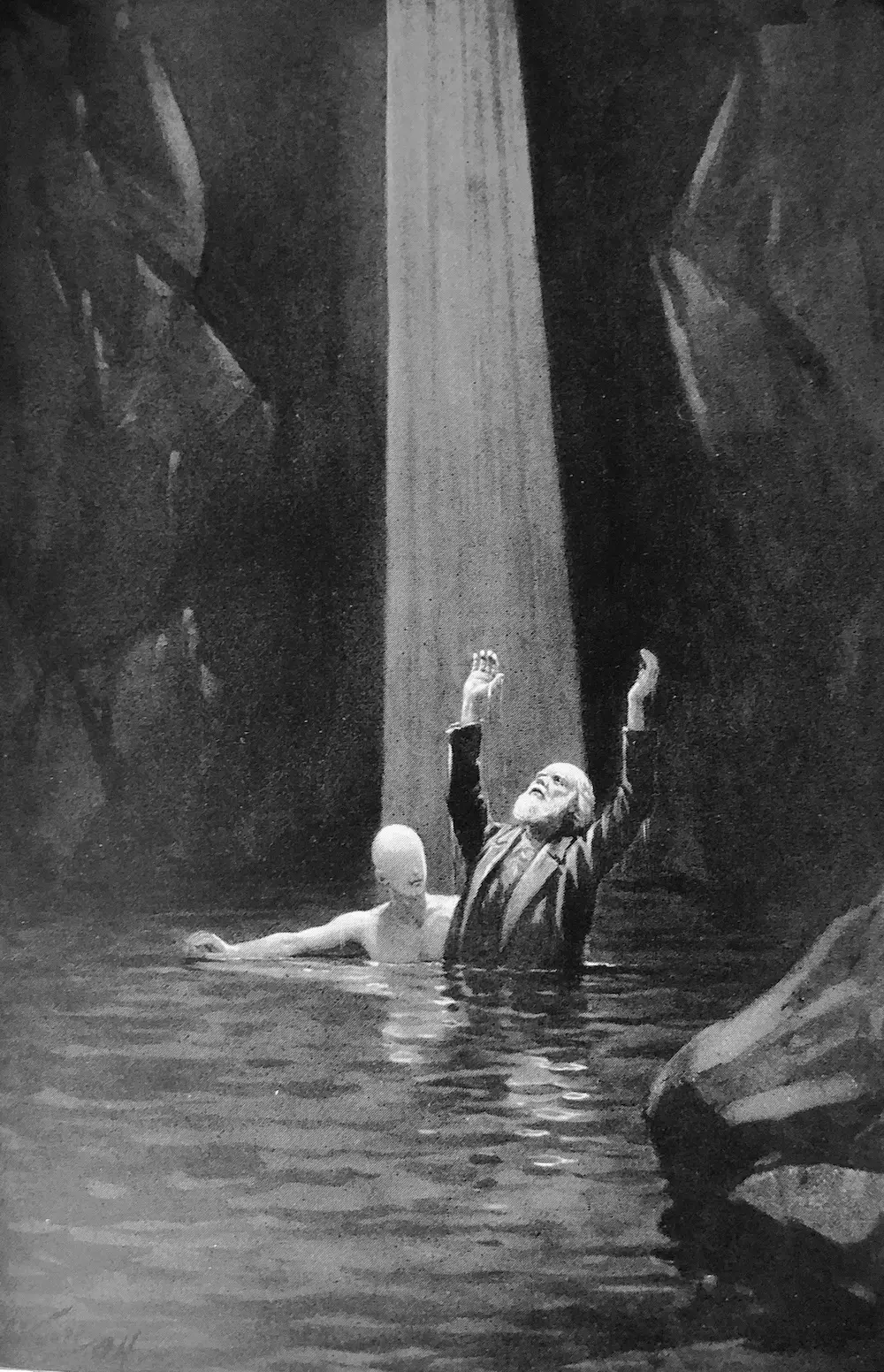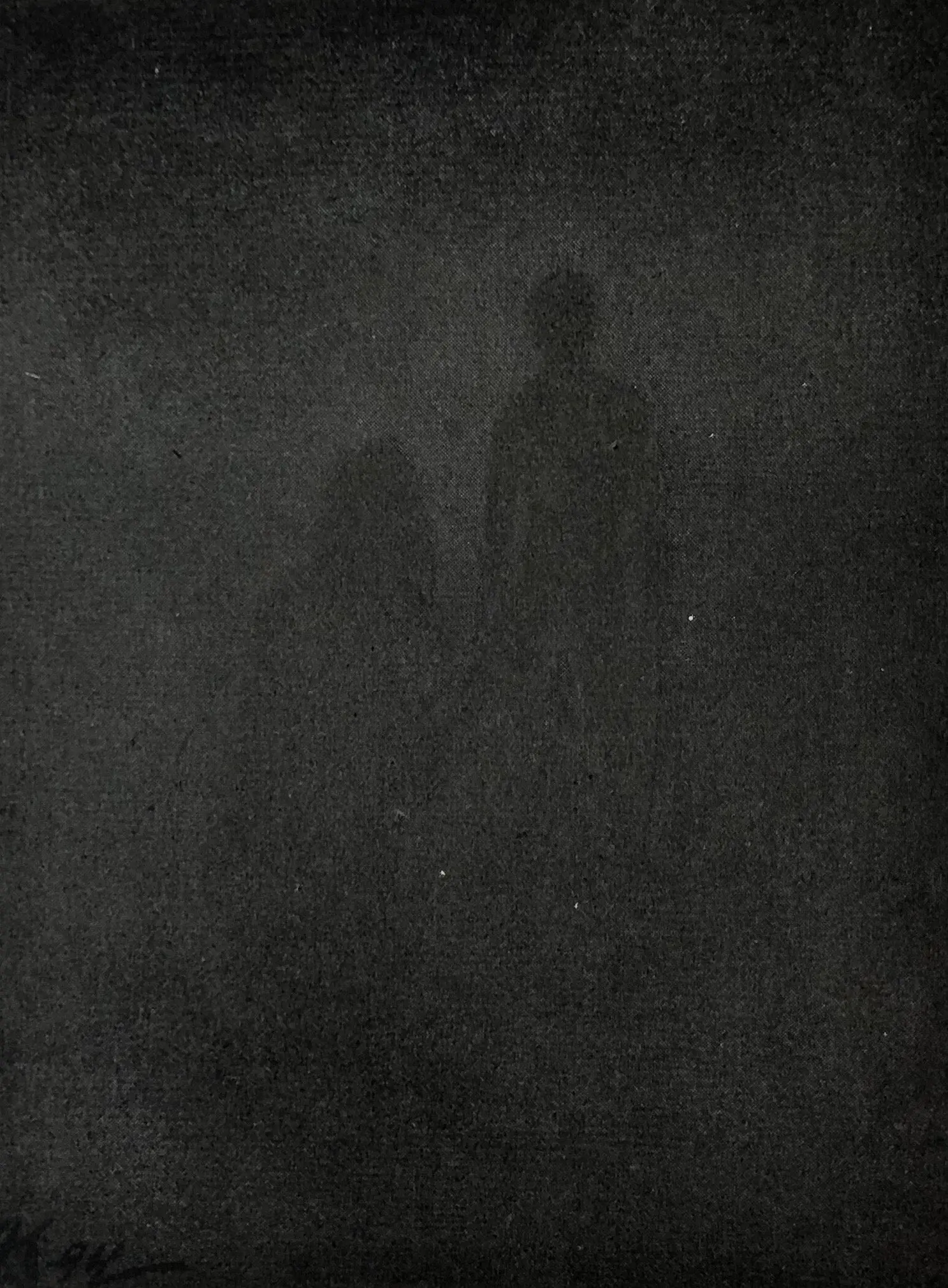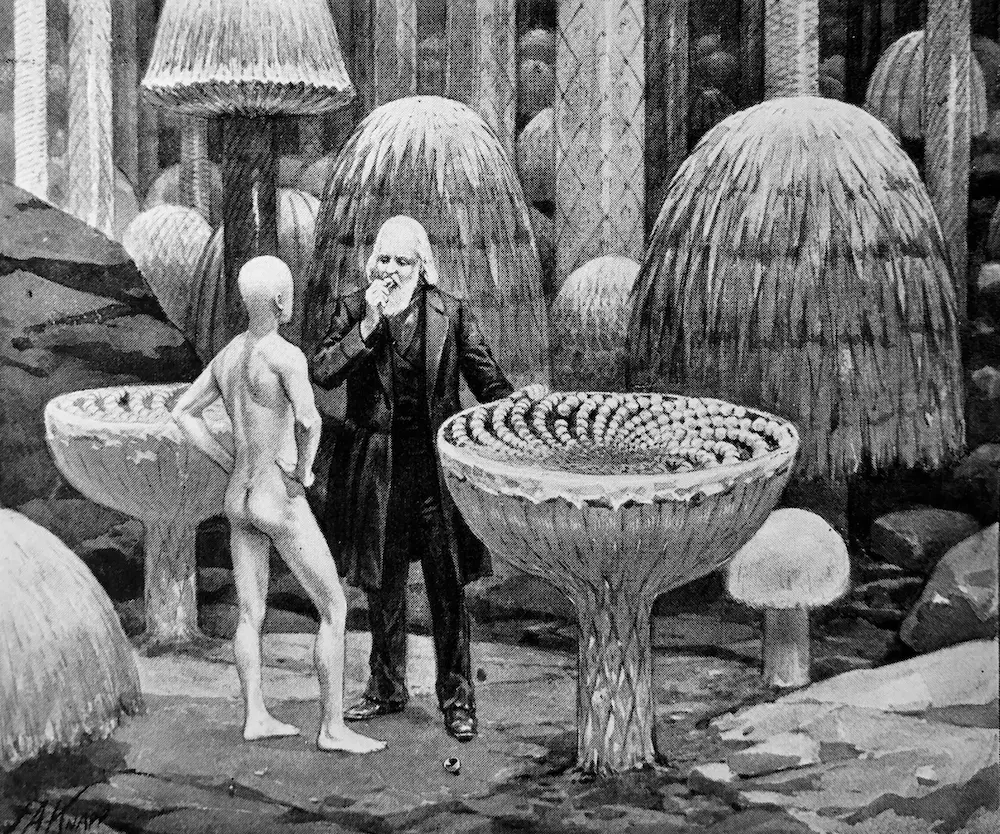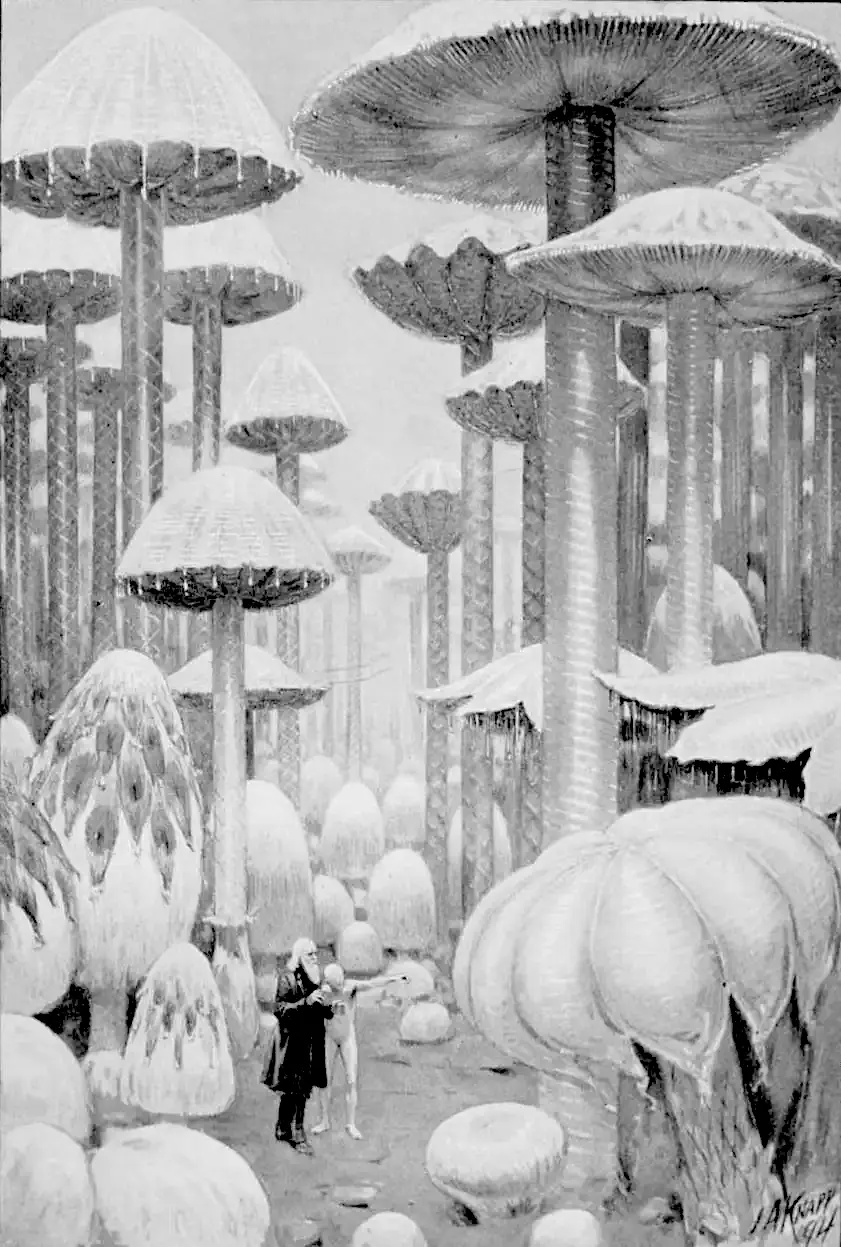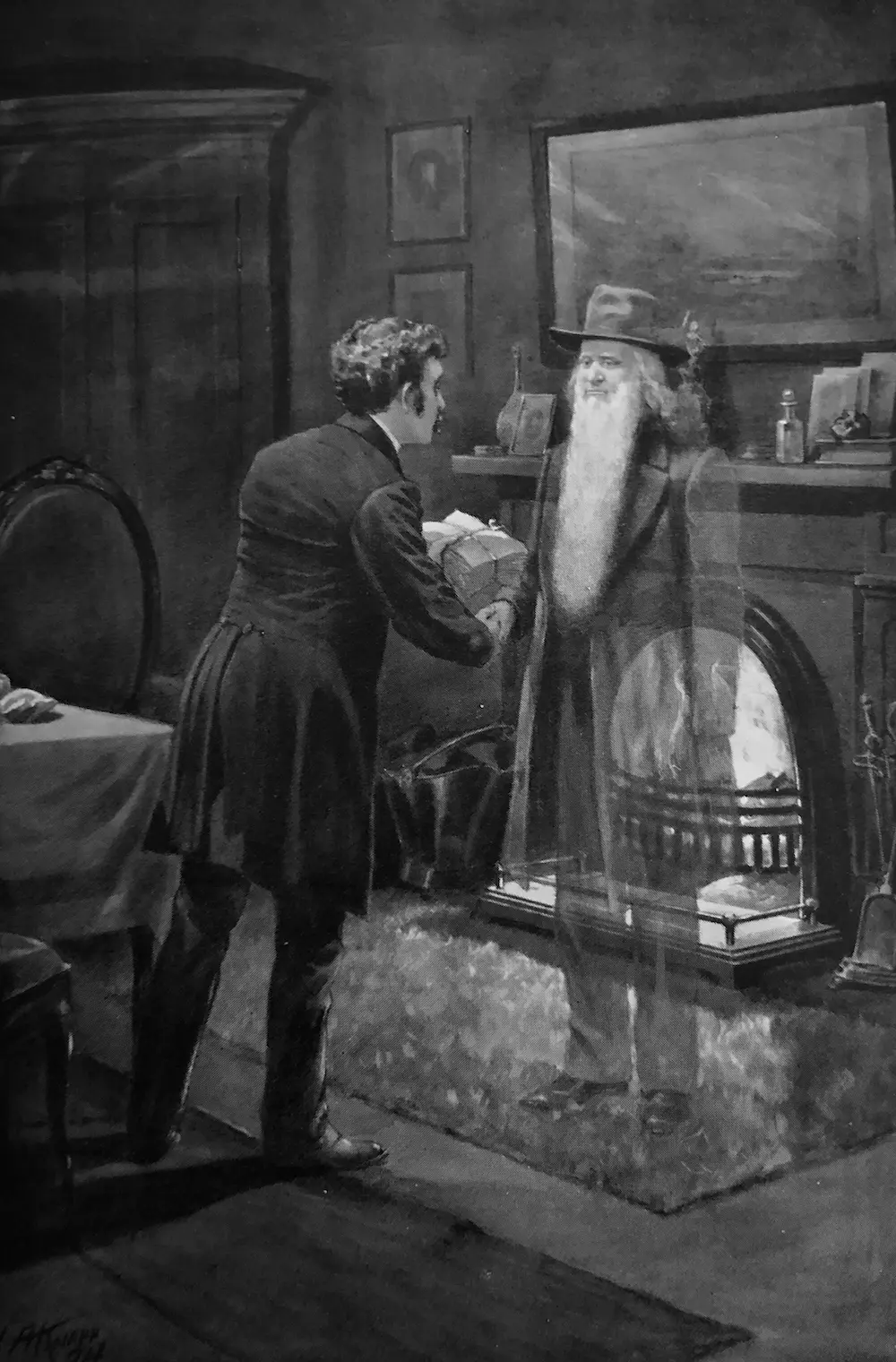Etidorhpa: The End of Earth (1895)
John Uri Lloyd
Complete subtitle: “The strange history of a mysterious being and the account of a remarkable journey as communicated in manuscript to Llewellyn Drury who promised to print the same, but finally evaded the responsibility which was assumed”
This groundbreaking meta-textual fantasy novel concerns a mysterious spectral visitor who claims to have journeyed to the center of the earth and received mystic wisdom. The book has reached new audiences in the 21st century due to its detailed nightmare fuel illustrations, but is worth appreciating as a celebration of the printed word and the often permeable barrier between fact and fiction.
There isn’t a single genre that fully captures Etidorhpa—it contains elements of utopianism, science fiction, and postmodernism, but also anticipates psychedelic literature and New Age fiction. It could be shelved next to House of Leaves or books on astrology. Early editions are thoughtfully crafted physical objects in conversation with each other.
I focus here on the specific material elements of one of the printings of the first edition and its relationship to its successors; the interleaved biographies of real people who were adjacent to the author and his book; and spotlight the weird and wonderful illustrations by John Augustus Knapp that first brought me and many other readers to the work.

Frontmatter and preface
The first printing of the 1895 edition—the self-titled “Author’s Edition”—features prodigious introductory material: an inserted slip of a colophon; a note to subscribers in the form of two onion-skin pages of reproduced handwriting including amendations and corrections; an ascription crediting the illustrator and editor; a baroquely illustrated preface that Lloyd acknowledges in a later printing is “vaguely-worded”; a table of contents; a list of illustrations; and finally a prologue, which marks the beginning of the actual fictional work—the first part not written by “John Uri Lloyd.”
The note to subscribers is tricky to reproduce digitally and does not appear in the Project Gutenberg edition, but I’ve attempted a faithful rendition of the subscribers’ note here. All (presumably deliberate) spelling errors are preserved, but hyphens have been removed:
To the recipients of the Authors edition of Etidorpha.
One whose study of the materials has
[to himself]
dispelled discredited
materialism and who sees in every form of matter a marvel inexplainable;
who considers fact to be as strange as fiction and that things visible
are but verses in God’s wonder book; who believes a fairy story to be
not less real true than
many visions scientific and that mind cannot conceive of creatures more
wierd or strange
wonderful than Nature creates
fashions; who believes that fancy
cannot carve thought matter into structures more
weird and grotesque than God creates
in objective fact; that force and
spirit are neither less real one than the other and that matter is not
more substantial real than either; who
loves the mysterious and the beautiful and sees mystery and beauty in
all visible structures and all possible thought creations; who questions
if a line can be drawn between fact and fiction or if man can
demonstrate where real things end and those fanciful begin; who
questions if enthusiasm intense is far separated from sarcasm deep; who
believes the cynic is often more of an educator than the sage and that
the study of matter may finally bring man to question if the very
attributes of matter are not qualities of force; — should not, in the
record that follows, attempt to differentiate between history and
romance, fact and fancy, speculation and science, sarcasm, ignorance and
irony. Consequently the writer will make no
[subsequent] comments concerning
on the work to follow.
Respectfully
John Uri
Lloyd
Norwood, Ohio
July 4th, 1895
This introduction, which in the author’s edition was signed by the writer, is here reprinted in order that my views of the book not be misconstrued — J. U. L.
Narrative structure
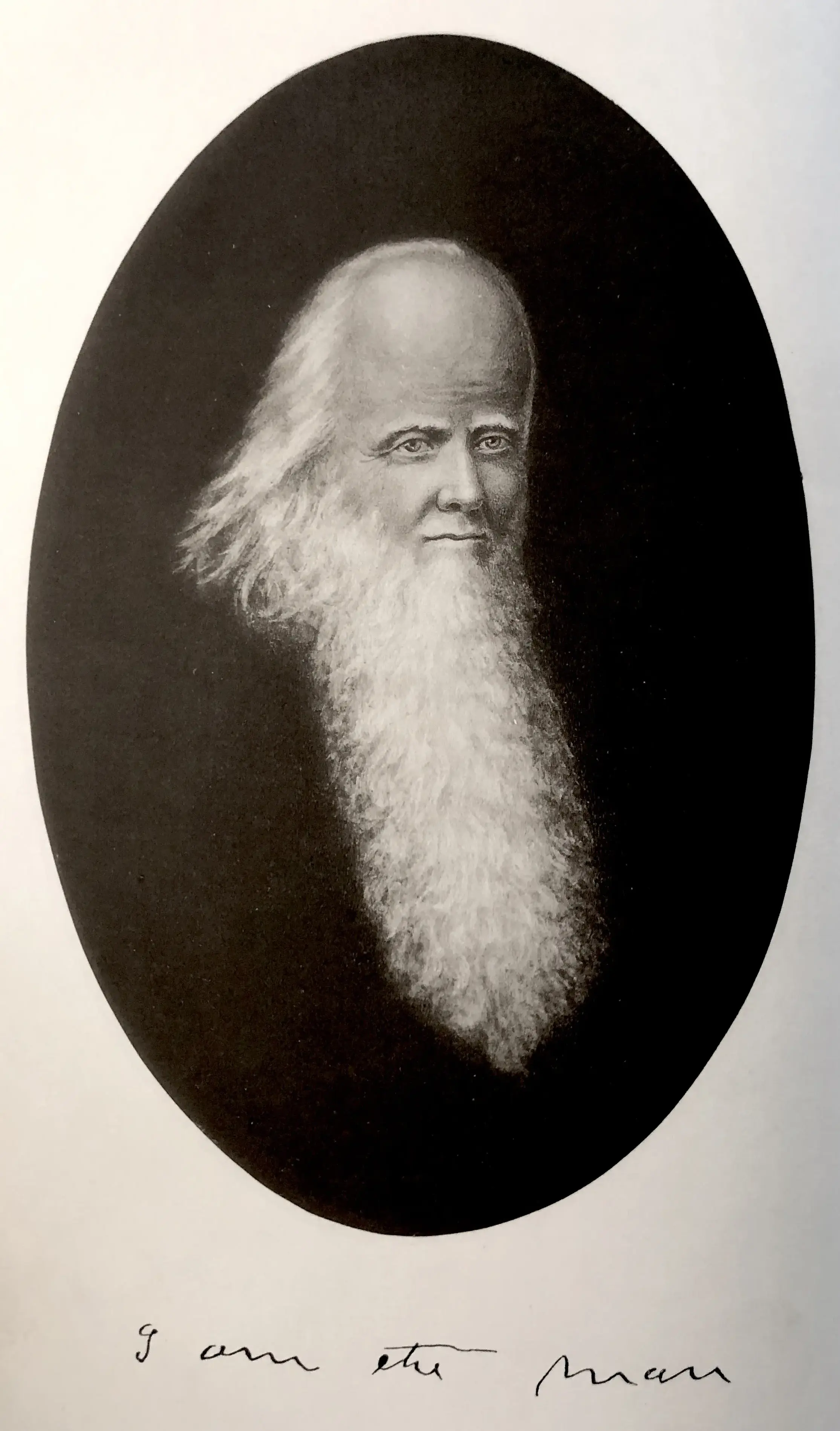
It’s not uncommon for 19th century novels to have a fictional narrator, but Etidorhpa is especially exuberant in this respect, with three layers of nested fictional narration: actual human person John Uri Lloyd “receives” the manuscript from the fictional person Llewellyn Drury, who recounts his visitations by a large-headed being known only as I—Am—The—Man:
“What shall I call you?”
“Why call me aught? It is not necessary in addressing each other that any name be used.”
“But what are you?” I persisted.
A pained expression for an instant rested upon his face, and he said, sadly, pausing between the words: “I—Am—The—Man—Who—Did—It.”
“Did what?”
“Ask not; the manuscript will tell you. Be content, Llewellyn, and remember this, that I—Am—The—Man.”
Often the narrator (either Drury or I—Am—The—Man) will recite or read a passage from another work and a citation appears in a footnote. Often the footnote is signed by Lloyd, as if he were a scholar who dug up the citation through extensive research rather than the author of the entire work. In a typical example, Drury consults a scholarly friend about whether he has dreamt his encounters with I—Am—The—Man, and his colleague quotes a passage on visions and hallucinations:
The Professor hereupon glanced over his bookshelf, selected a volume, and proceeded to read: *
“I generally saw human forms of both sexes; but they usually seemed not to take the smallest notice of each other, moving as in a market place, where all are eager to press through the crowd; at times, however, they seemed to be transacting business with each other. I also saw several times, people on horseback, dogs, and birds.”
* This work I have found to be Vol. IV. of Chambers’ Miscellany, published by Gould and Lincoln, Boston.—J. U. L.
In the modern era we can check Lloyd’s “research” and confirm that indeed, the citation is correct (the cause of the hallucination here is attributed to insufficient blood-letting).
Eventually I—Am—The—Man consents to turning over the manuscript describing his experiences, though Drury complains that the “chirography” (handwriting) is very poor and he needs it read aloud. A handwriting sample is included to substantiate his claim. It seems likely this is from Lloyd’s own manuscript (the barely-readable excerpt is from Chapter 25) and is a self-deprecating joke at his own expense.
Journey to the End of Earth
You are not to be destroyed; we only wish to do your
bidding.
I—Am—The—Man details how, in search of ancient cabalistic wisdom, he descends into Mammoth Cave, Kentucky. His guide is an eyeless, hairless, naked man “the color of light blue putty.” This mysterious being is unnamed but is instantly memorable from the book’s illustrations.
I—Am—The—Man and his “uncouth new associate” descend ever-deeper into the cave system, mostly in total darkness. The narrator observes that he’s not getting tired, and his guide tells him that the cave exudes an “intrinsic vitalizing power that neutralizes fatigue”. The eyeless man further reinvigorates him with some “strange edibles,” which later turn out to be exactly what you think.
Each stage of their descent doubles as a lecture on a different scientific principle, and an opportunity for “John Uri Lloyd” to offer a gentle corrective or addition in the form of a footnote—at one point dubiously claiming that Kentucky residents use large fungi to perfume their homes and prop open their doors.
In Chapter 20 the inner narrative is abruptly interrupted for the first time by Llewellyn Drury (“Remember that I relate a story within a story”). He challenges the veracity of I—Am—The—Man’s assertion that a huge deposit of salt cliffs exists beneath the earth (apparently an eyeless humanoid guide can pass without comment). Thus follows a truly unnnecessary digression about specific gravity that is presumably Lloyd once again wanting to educate his audience at any cost to pacing or reader patience. Regretfully this pattern will repeat throughout the novel.
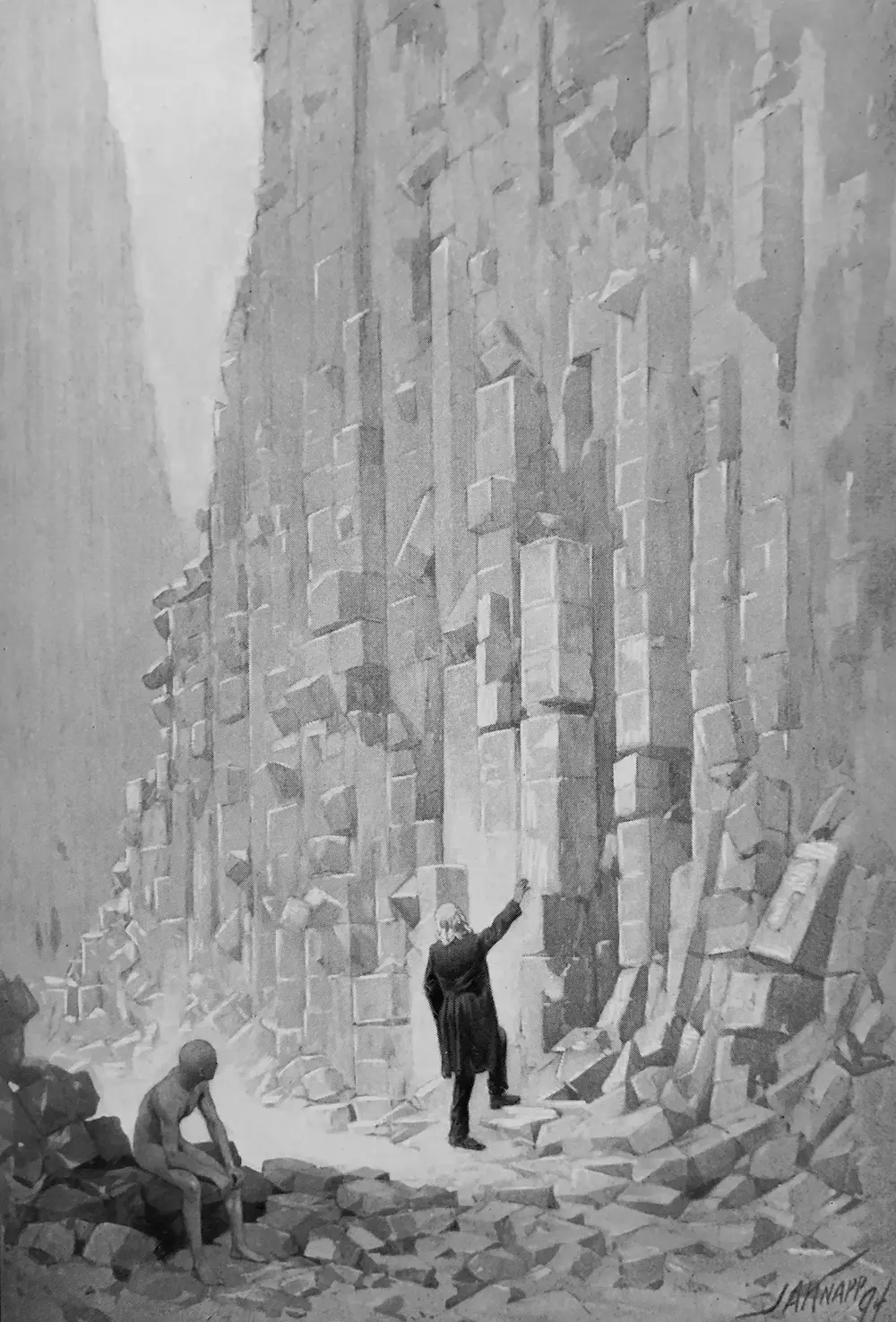
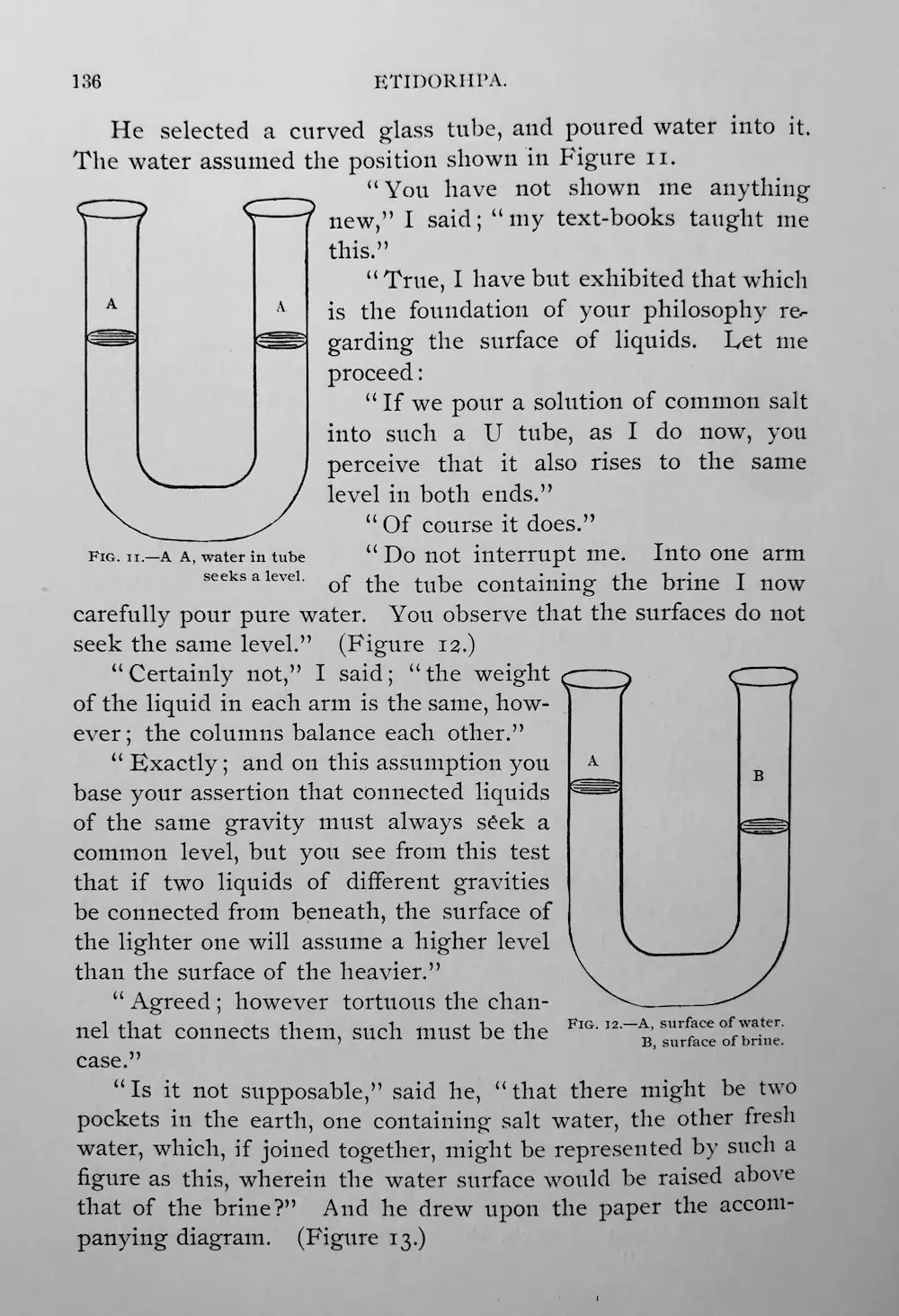
“Gravitation is the beginning and gravitation is the end; all earthly bodies kneel to gravitation”
In Chapter 21 the descent story resumes, if briefly, to explore the diminishment of gravity beneath the earth. After detailing his experience in near-weightlessness, I—Am—The—Man encourages Drury to “establish or disprove” his account, and the reader is again returned to the middle layer of the narrative. (Gravity does in fact weaken as one passes through the interior of a planet, though the effect is more complicated than 19th century scientists could model.)
This digression serves as an opportunity for Lloyd to have his fictional Drury interview various actual scientists from the Cincinnati area. The largest cameo is by Professor Daniel Vaughn, deceased at the time of the novel’s writing, whose “soliloquy” gets increasingly baroque over the chapters allotted to him:
“The suns and universe of suns about us may be the only vacant points in the depths of an all-pervading entity in which even thyself [gravity] dost exist as a momentary echo, linked to substances ponderous, destined to fade away in the intersellar expanse outside, where disturbances disappear, and matter and gravitation together die, where all is pure, quiescence, peaceful, and dark.”
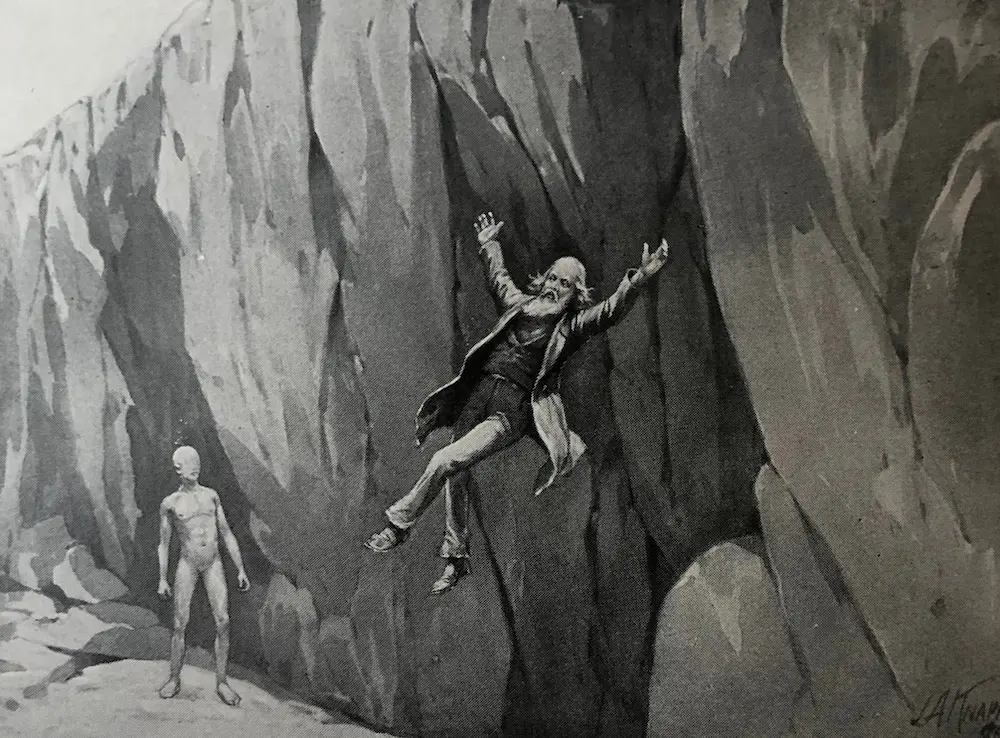
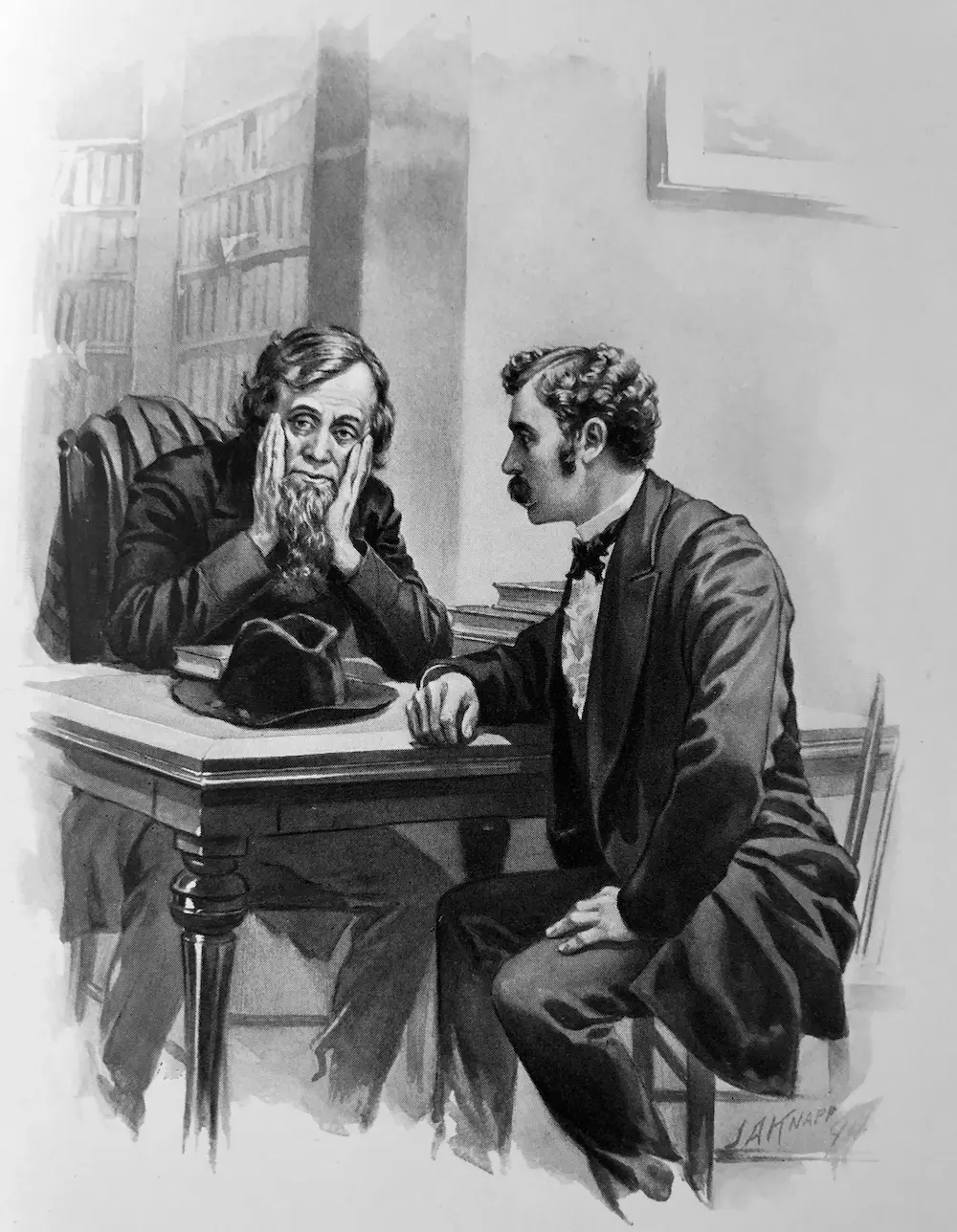
“Beware of your own brain.”
The reader is invited to skip this chapter of horrors. —
J.U.L.

The back-and-forth between the interlocking narrators continues; I—Am—The—Man later describes an underground lake of perfectly still water over which he and the eyeless creatured sailed at 900 miles a hour. Drury disputes the plausibility of this. They argue over the behavior of wells (more tedious scientific diagrams are employed). Drury scoffs that he’d sooner believe he could “see my own brain” than that water could behave as described. Then a curious tonal change occurs in Chapter 29 when I—Am—The—Man agrees to indeed show Drury his own brain, with a caution about the moral limits of scientific inquiry.
I—Am—The—Man recalls a scientist who, in the mode of Dr. Frankenstein, becomes obsessed with dissecting corpses to discover the animating force of life. It’s a much more visceral, explicitly horrific story than Mary Shelley’s (not the least because it’s cast as fact), and because it climaxes in the vivisection of kidnapped children—
I—Am—The—Man continued: “With the cunning of a madman, this person of profound learning, led from the innocence of ignorance to the heartlessness of advanced biological science, secretly planned to seek the vital forces. ‘I must begin with a child, for the life essence shows its first manifestations in children,’ he reasoned. He moved to an unfrequented locality, discharged his servants, and notified his former friends that visitors were unwelcome. […] From the inner room of that house no cry could be heard by persons outside…”
—before Lloyd interrupts in the middle of the page:
It will be seen, by referring to the epilogue, that Mr. Drury agreed to mutilate part of the book. This I have gladly done, excising the heart-rending passages that follow. To use the words of Prof. Venable, they do not “comport with the general delicacy of the book.” — J. U. L.
This is referencing the section of the epilogue in which I—Am—The—Man instructs Drury on how the novel must be published, and Lloyd indicates that he has complied:
“You must mutilate a page of the manuscript that you may select, and preserve the fragment intact and in secret. Do not print another edition unless you are presented with the words of the part that is missing.” *
* I have excised a portion [see page 190] — J. U. L.
Eat me
Etidorhpa may contain the earliest description of a psychedelic trip in Western fiction, in the chapters in which I—Am—The—Man eats from a giant fungus that grows miles deep beneath the earth, and hallucinates monstrosities with enormous and distended body parts.
These tortured beings are “Drunkards” and at first the hallucinations read like standard Abstinence-era scaremongering, especially when the angelic Etidorhpa—“Aphrodite” reversed—arrives to lecture the reader on moral purity. But the visions that I—Am—The—Man has upon consuming the mushroom have particular qualities of dissociation, ego death, and time dilation as experienced on a cosmic scale:
I perceived that the sun, and moon, and stars, nearly stilled, dim and motionless, had paled in the cold depths of space. The universe itself was freezing, and amid the desolation only my deserted intellect remained. Age after age had passed, aeons of ages had fled, nation after nation had grown and perished, and in the uncounted epochs behind, humanity had disappeared. Unable to free itself from the frozen body, my own intellect remained the solitary spectator of the dead silence about. At last, beneath my vision, the moon disappeared, the stars faded one by one, and then I watched the sun grow dim, until at length only a milky, gauze-like film remained to indicate her face, and then—vacancy. I had lived the universe away.
Psilocybin would not be unambiguously described by Westerners until in 1957, when Life magazine published Gordon Wasson’s “Magic Mushrooms”, his account of his experiences mediated by María Sabina, an indigenous Mazatec healer. “On the night we have described we lived through eons,” Wasson wrote, in language that echoes Lloyd’s.
Many researchers of entheogenic and psychoactive substances, including Terence McKenna, have believed Lloyd’s account to be based on personal experience, and like Alice in Wonderland the book influenced counterculture iconography. It’s plausible that Lloyd’s mycologist brother, Curtis Gates Lloyd, would have collected mushrooms in the Psilocybe family—their native distribution includes North America—but no such specimens have been identified in Lloyd’s collection, and he did not return to the subject in his later writing.
Nevertheless, Lloyd’s coy footnote at the end of the chapter more or less asserts that he was aware of the existence of drugs that, in minute doses, could provide transformative experiences unlike any other narcotic known to date:
If, in the course of experimentation, a chemist should strike upon a compound that in traces only would subject his mind and drive his pen to record such seemingly extravagant ideas as are found in the hallucinations herein pictured, or to frame word-sentences foreign to normal conditions, and beyond his natural ability, and yet could he not know the end of such a drug, would it not be his duty to bury the discovery from others, to cover from mankind the existence of such a noxious fruit of the chemist’s or pharmaceutist’s art? To sip once or twice of such a potent liquid, and then to write lines that tell the story of its power may do no harm to an individual on his guard, but mankind in common should never possess such a penetrating essence. Introduce such an intoxicant, and start it to ferment in humanity’s blood, and it may spread from soul to soul, until, before the world is advised of its possible results, the ever-increasing potency will gain such headway as to destroy, or debase, our civilization, and even to exterminate mankind. — J. U. L.
The last debates
Drury and I—Am—The—Man squabble in the remaining chapters over whether this account is credible, including a genuinely comical dialogue about the limitations of observable fact. Maybe Lloyd had tired of the length of the novel by now, because I—Am—The—Man mentions offhandedly that he encountered many wonders he didn’t bother to describe, but are nevertheless illustrated and even re-illustrated:

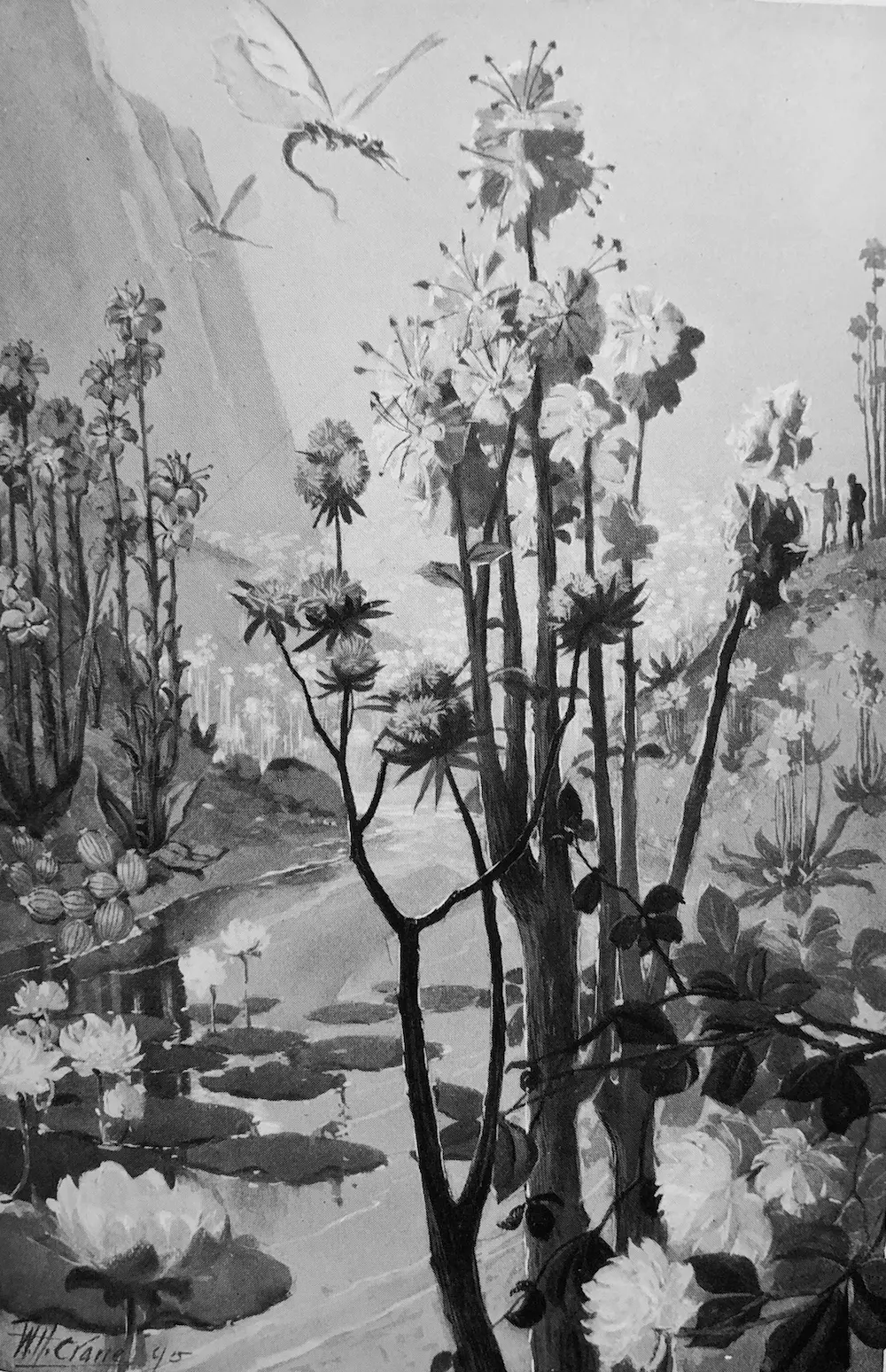
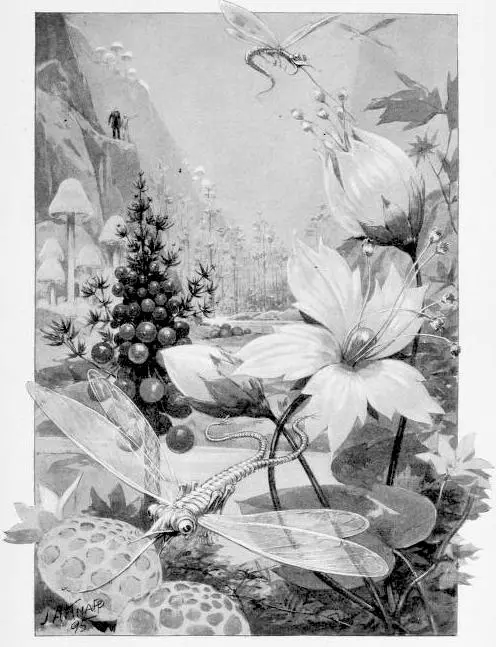
A helpful map is provided of the journey thus far, orienting the reader to the location of the great, quiet interior of the earth’s crust, the “Sphere of Rest”, point P:

Here I—Am—The—Man and the eyeless being have reached a great cliff marking the edge of the earth’s interior; what lies beyond are the vaguely-defined celestial spheres of the “Inner Circle” and “Unknown Country.” I—Am—The—Man opts to pass into the Unknown Country, requiring that he give up all claim to his earthly body and family—his wife and kids a mere afterthought on his journey into enlightenment. He passes the illegible manuscript to Drury with instructions on its publication. Drury complains, “And I am not to receive the remainder of your story?”, incredulous that the knowledge gained beyond the End of Earth is apparently out of scope. I—Am—The—Man asks him to check in on his abandoned family and then peaces out.
John Uri Lloyd would publish more books, from tracts on elixirs to comprehensive pharmacopoeia to other novels late in life, but nothing like Etidorhpa. Today he is best remembered for his vast library on botany and eclectic medicine; the collection is housed by the Lloyd Library and Museum in his home town of Cincinnati. The gift shop offers mushroom mouse pads.
If Lloyd himself experienced the transcendental visions of an infinite cosmos that he described, they did not, in the end, give him unique foresight or judgment. He was a “lifelong Democrat” in the Reconstruction-era Midwest—this is bad!—and accounts of his life brush aside his truly repellent fictionalized hagiographies of the Confederacy and antebellum Kentucky. Like nearly all white Americans of his era, he left behind a conflicted legacy—a sour postscript to a mystical and empathetic book.

References and further exploration
- First edition, facsimile
- Second edition, facsimile
- Sixth edition HTML, Project Gutenberg
- The Public Domain Review article and analysis
- On J. A. Knapp’s occult paintings
- Lloyd’s contribution to Confederacy revisionism
